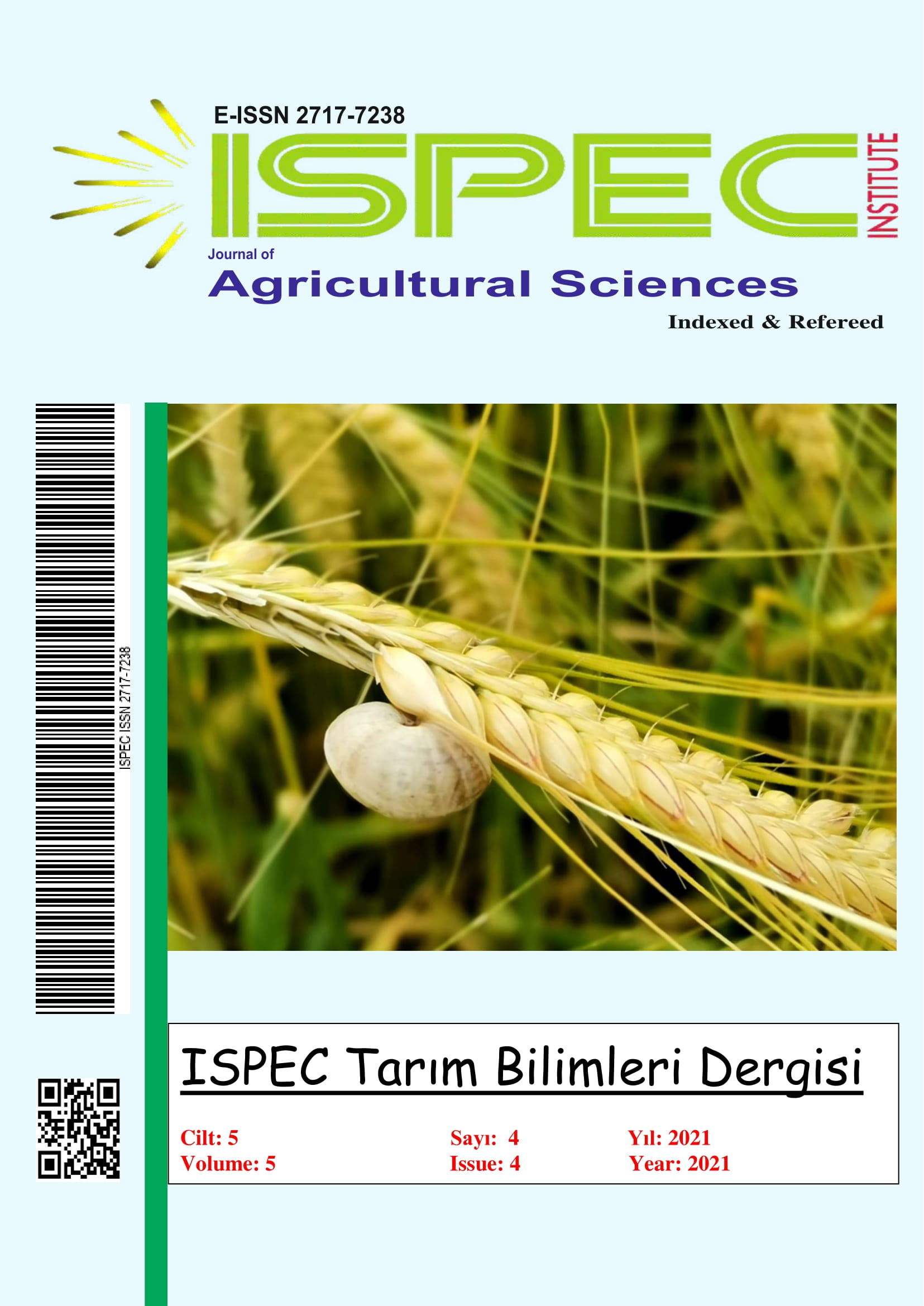The Effect of Treated Waste Water Levels on Germination growth of Grass pea (Lathyrus sativus L.) Genotypes
DOI:
https://doi.org/10.46291/ISPECJASvol5iss4pp919-926Keywords:
Grass pea, genotype, waste water, germinationAbstract
Global climate change, rapidly increasing world population has put pressure on fresh water resources and this pressure has pushed the agriculture sector to seek alternative water sources. The treated wastewater is one of these sources. In this study, the effects of different levels of treated waste water (0, 25%, 50%, 75% and100%) on the germination development of grass pea were investigated. The 4301 landraces and GAP Blue variety were used as plant material. The study was arranged as split plots in randomized complete blocks design with 4 replications. Germination rate, root length, shoot length, root fresh and dry weight, shoot fresh and dry weight, vigour index were examined in the study. As a result, it was determined that 4301 landraces responded positively to the treated wastewater as much as the Gap Blue variety. Besides, it was observed that treated wastewater levels increased all properties up to 75%.
References
Abdul-Baki, A.A., Anderson, J.D. 1973. Vigour determination in soybean seed by multiple.
Aküzüm, A., Selenay, F., Çakmak, B. 2010. Sulama yönetimi ve sürdürülebilir su
kullanımı. 1. Sulama ve Tarımsal Yapılar Yapılar Sempozyumu 27-29 Mayıs 2010. Kahramanmaraş Sütçü İmam Üniversitesi Ziraat Fakültesi Tarımsal Yapılar ve Sulama Bölümü. Cilt:1 s. 262-278.
AI-Rashed, M.F., Sherif, M.M. 2000. Water Resources in the GCC Countries: an Overview. Water Resour. Mgt., 14(1): 59-73.
Angelakis, A.N., Do Monte, M.M., Bontoux, L., Asano, T. 1999. The status of wastewater reuse practice in the mediterranean basin: Need for Guidelines. Water Research, 33(10): 2201-2217.
Başaran, U., Mut, H., Önal-Aşcı, Ö., Acar, Z., Ayan, İ. 2011. Variability in forage quality of Turkish grass pea (Lathyrus sativus L.) landraces, Turkish Journal of Field Crops, 16(1): 9-14.
Chung, B.Y., Song, C.H., Park, B.J., Cho J.Y. 2011. Heavy metals in brown rice (Oryza sativa L.) and soil after long-term ırrigation of wastewater discharged from domestic sewage treatment plants. Pedosphere 21: 621-627.
Copeland, L.O., McDonald, M.B. 2001. Principles of seed science and technology. Kluwer Academic Publishers, Massachusetts, USA, pp. 467.
Çopur Doğrusöz, M., Gülümser, E., Başaran, U., Mut, H. 2021. Alkali Stresinin Farklı Mürdümük Geneotiplerinde (Lathyrus sativus L.) Çimlenme Gelişimine Etkisi. ISPEC Tarım Bilimleri Dergisi, 5(2): 257-266.
Daifi, H., Alemad, A., Khadmaoui, A., El hadi, M., El kharrim, K. and Belghyti, D. 2015. Effect of purified ındustrial wastewater on the growth of tomato plant (Lycopersicon esculentum). Int. J. Pure App. Biosci. 3(4): 57-64.
Das, N., R. 2000. Lathyrus sativus in rainfed multiple cropping systems in west bengal. Indiaa Review. Lathyrus Lathyrism Newsletter 1: 25-27.
Dash, A.K. 2012. Impact of domestic wastewater on seed germination and physiological parameters of rice and wheat. Int. J. Res. Rev. Appl. Sci.,12: 280-286.
Daud, M.K., Hassan, S., Azizullah, A., Jamil, M., Rehan, N., Irum, R., Qaiser, M.K., Zhu, S.J. 2016. Physiological, biochemical, and genotoxic effects of wastewater on maize seedlings. Polish Journal of Environmental Studies, 25(2): 563-571.
Gassama, U.M., Puteh, A.B., Abd-Halim, M.R., Kargbo, B. 2015. Influence of municipal wastewater on rice seed germination, seedling performance, nutrient uptake, and fchlorophyll content. Journal of Crop Science and Biotechnology, 18(1): 9-19.
Kardeş, Y.M., Mut, Z., Gültaş, H.T., Erbas Köse, Ö.D., Karaer, M. 2019. Effect of treated wastewater on germınatıon and seedlıng growth of two different bean (Phaseolus vulgaris L.) cultivar. III. International Eurasian Agriculture and Natural Sciences Congress, 17-19 October, Antalya, Turkey.
Kardeş, Y.M., Karaer, M., Erbas Köse, Ö.D., Mut, Z. 2020. The effect of treated wastewater applications on germination and seedling growth in three different corn (Zea Mays L.) cultivar. Bilecik Seyh Edebali University Journal of Science, 7(1): 113-120.
Khan, M.A., Shaukat, S.S., Hany, O., Jabeen, S. 2010. Irrigation of sorghum crop with waste stabilization pond effluent: growth and yield responses. Pak. J. Bot, 42(3): 1665-1674.
Korukçu, A., Büyükcangaz, H. 2003. Su ve sulama yönetimine bütünsel yaklaşım. 2. Ulusal Sulama Kongresi. 16-19 Ekim, Kuşadası, İzmir.
Mihailovic, V., Mikic, A., Cupina, B., Krstic, D., Antanasovic, S., Radojevic, V. 2013. Forage yields and forage yield compositions in grass pea (Lathyrus sativus L.). Legume Research, 36(1): 67-69.
Noto, F., Poma, I., Gristina, L., Venezia, G., Ferrotti, F. 2001. Bioagronomic and qualitative haracteristics in Lathyrus sativus lines. In: Proceedings 4th European Conference on Grain Legumes (eds. AEP) 8-12 July 2001, Cracow, Poland. P 183.
Öten, M., Kiremitci, S., Erdurmuş, C. 2017. Mürdümükte (Lathyrus sativus L.) tane ve kuru ot verimi ile ilişkili özelliklerin korelasyon ve path analizi ile saptanması. Derim, 34(1):72-78.
Özcan, S., Oluk, S. 2005. Arıtılmış atık suların bazı çim türlerinde tohum çimlenmesi ve fide gelişimi üzerine etkileri. Kastamonu Eğitim Dergisi, (13):159-162.
Ramana, S., Biswas, A.K., Kundu, S., Saha, J.K., Yadav, R.B.R. 2002. Effect of distillery effluent on seed germination in some vegetable crops. Biores. Technol., 82: 273-275.
Saravanamoorthy, M.D., Kumari, B.D.R. 2007. Effect of textile wastewater on morphophysiology and yield on two varieties of peanut (Arachis hypogaea L.). J. Agric. Technol., 3: 335-343.
Singh, R., Kumar, S., Nangare, D.D., Meena, M.S. 2009. Drip ırrigation and black polyethylene mulch ınfluence on growth, yield and water-use efficiency of tomato. African Journal of Agricultural Research, 4(12): 1427-1430.
Urga, K., Fufa, H., Biratu, E., Husain, A. 2005. evaluation lathyrus sativus culivated in ethiopia for proximate composition, minerals, â-odap and anti-nutritional components. African Journal of Food Agriculture and Nutritional Development, 5(1): 1-15.
Yousaf, I., Ali, S.M., Yasmin, A. 2010. Germination and early growth response of Glycine max varieties in textile and paper industry effluents. Pak. J. Bot. 42: 3857-3863.
Downloads
Published
How to Cite
Issue
Section
License
Copyright (c) 2021 The copyright of the published article belongs to its author.

This work is licensed under a Creative Commons Attribution-NonCommercial 4.0 International License.



